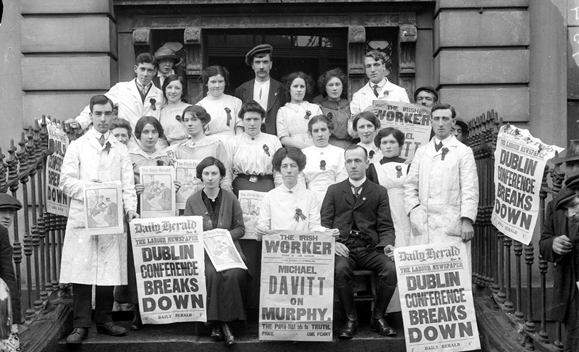The nephew of trade unionist Rosie Hackett has said she would be “giggling quietly to herself” if she knew that Dublin’s newest bridge, which spans the Liffey over Marlborough Street, had been named in her honor.
“She’d be slightly embarrassed about it, but she’d also be very proud,” John Gray, Rosie’s nephew, said speaking on the radio show “Morning Ireland.”
Rosie, a founding member of the Irish Women Workers’ Union, was involved in the 1913 Dublin Lockout, and the Irish Citizen Army during the 1916 Rising.
It is the first time that a bridge over the Liffey, immortalized by James Joyce as the muse Anna Livia Plurabelle, has been named for a woman.
The Dublin Lock-out, the most significant industrial dispute in Irish history, lasted from August 26, 1913 to January 18, 1914. Central to the strike was the right to unionize. Workers were forced to labor up to 17 hours a day, and were at the mercy of their employers, who blacklisted them if they tried to unionize.
William Martin Murphy who, among other interests, was the chairman of the Dublin United Tramway Company, was particularly opposed to unionizing workers and saw Jim Larkin, who set up the General Workers’ Union (ITGWU), as a dangerous revolutionary.
Presiding over a meeting of 300 other employers, Murphy, and the group determined to take on the ITGWU. On August 15, Murphy dismissed 40 workers he suspected of being union members and dismissed 300 more the following week. Thus began the strike, with employers locking out workers and employing scab labor from Britain.
Guinness was the one notable employer that did not lock out its workers, even though 400 of its employees were union members. But some 20,000 other Dublin workers took part in the strike. As they were already the poorest paid workers in Europe, the dispute drove them to the edge of starvation, but they refused to break the strike.
Rosie Hackett was very active in the ITGWU. As a co-founder (with Jim Larkin’s sister Delia) of the Irish Women Workers’ Union, she had organized the 1911 women workers strike at Dublin’s Jacob’s biscuit factory.
Rosie’s nephew also said that although she was small in stature, she had a big character: “If she seen [sic] something that was wrong, she’d do something to right it. Not just for her sake, but primarily for others.”
The new bridge, which is costing an estimated €13 million, is due to open in February.
Rosie Hackett’s Memorial Bridge


Leave a Reply